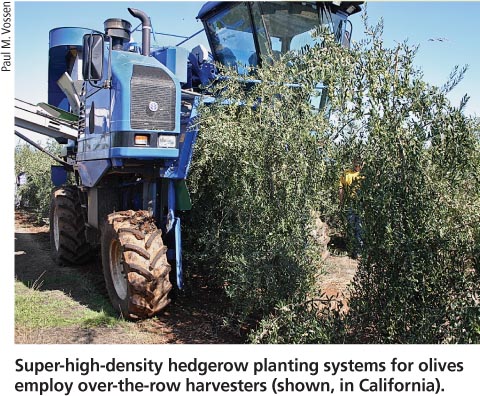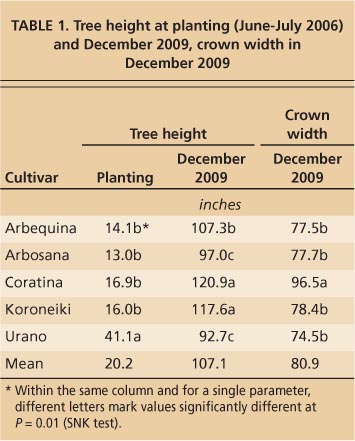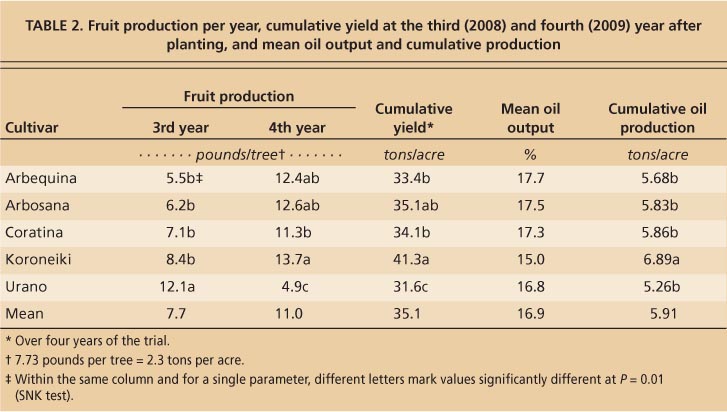All Issues
Sidebar: Olive cultivars field-tested in super-high-density system in southern Italy
Publication Information
California Agriculture 65(1):39-40. https://doi.org/10.3733/ca.v065n01p39
Published January 01, 2011
Full text
According to the International Olive Oil Council, world olive oil consumption has risen from 2.8 million tons (1991-1992) to 3.5 million tons (2005-2006), due to increases in the consumption of healthier foods in many countries, including the United States. The market outlook for extra-virgin olive oil is very good, and many countries are actively increasing their olive acreages, particularly in North Africa, the Middle East, South America, Australia and the United States (Godini 2010).
The Mediterranean's traditional olive industry is based on production systems that are hundreds of years old and characterized by low yields and high production costs. The European Union subsidy system, which has helped European olive farmers to stay in business, will end in 2014. Moreover, the application of a “free exchange” area in 2010 will legalize the importation of lower-cost extra-virgin olive oils from the southern Mediterranean Basin into Europe (Godini 2010). Year after year, the profitability of Italy's traditional olive culture becomes increasingly doubtful, notwithstanding the worldwide renown of so-called “Made in Italy” extra-virgin olive oil (Godini and Bellomo 2002).
Super-high-density hedgerow planting systems for olives employ over-the-row harvesters (shown, in California).
California production of extra-virgin olive oil is reportedly about 2% of total U. S. consumption, with the rest imported mainly from Italy and Spain. In recent years, California has started increasing its oil olive acreage. California olive growers have planted more than 22,000 acres since 1999, about 12,000 acres of which is in the super-highdensity olive system, with tree densities of 676 per acre or more. This system allows for mechanical planting and harvesting of olives, reducing labor costs.
We believe that super-high-density olive culture can help to assure profitability for both European and U. S. olive growers in the coming decades. This model, born in Spain at the end of the 20th century, has resulted in noticeable increases in yield per acre. Up until now, super-high-density olive culture has utilized a limited number of cultivars, primarily ‘Arbequina’, ‘Arbosana’ and ‘Koroneiki’, which possess suitable features such as a semi-dwarf habit, early bearing (first production at the second-to-third year after planting), consistent initial crops (more than 2.2 pounds per plant), crop stabilization between 5 and 6 years, and fruit that is impact-resistant and has good oil quality (Godini and Bellomo 2002).
The results that we present here are preliminary. Considering that Italy's Mediterranean climate is similar to California's, we believe that soil and climate differences should have little influence on the applicability of these findings to California.
Experimental orchard
In summer 2006, we established a new experimental orchard at Valenzano, near Bari, in the experimental farm of the Dipartimento di Scienze delle Produzioni Vegetali at University Aldo Moro of Bari, Italy. In addition to standard clones of ‘Arbequina’, ‘Arbosana’ and ‘Koroneiki’, two additional cultivars were introduced: ‘Coratina’, the most popular Apulian olive oil cultivar, and ‘Urano’, a new Italian cultivar considered by our research group to be well-suited for super-high-density olive culture.
The olive trees were propagated in commercial nurseries by softwood cutting, and the experimental orchard was established according to the super-high-density planting scheme (676 plant per acre, with a tree spacing of 157.5 inches by 59 inches) and a north-south row orientation. The trees were trained to central leaders. Drip irrigation was supplied to each tree every 3 days between late spring and late summer, increasing from 423 cubic yards per acre annually in 2006, to 476 in 2007, to 794 in 2008 and 2009. Harvesting was performed on Nov. 20 in 2008 and 2009, in the third and fourth years after planting, respectively, using the Pellenc Activ’ 4560 harvesting machine.
Cultivar performance
Vegetation.
In December 2009, the average tree height had reached 107 inches, 5.3 times the initial growth of the previous year, with a maximum of 7.6 times more growth for ‘Arbequina’ and a minimum of 2.2 times more for ‘Urano’ (table 1). Only the crown width of ‘Coratina’ exceeded 79 inches by December 2009, exceeding the harvester tunnel size and requiring pruning intervention to control its transverse canopy growth.
Annual yields.
The average annual yield in the third year was 7.7 pounds per tree, equivalent to 2.3 tons per acre; only ‘Urano’ exhibited a surprisingly high yield of 3.7 tons per acre (table 2). In the fourth year, the average crop yield was 11 pounds per tree or 3.3 tons per acre (up 40% from 2008), and it was more variable among cultivars. ‘Koroneiki’, ‘Arbosana’ and ‘Arbequina’ followed by ‘Coratina’ gave satisfactory yield (between 13.7 and 11.3 pounds per tree or 4.1 and 3.4 tons per acre). The yield for ‘Urano’ dropped to 4.9 pounds per tree or 1.5 tons per acre, perhaps due to heavy cropping in the previous year.
Cumulative yields and oil.
We also compared cumulative yields over the first 4 years of the trial. ‘Koroneiki’ showed the highest cumulative yield (41.3 tons per acre), and ‘Urano’ was relatively less productive (31.6 tons per acre) (table 2). The peculiar behavior of ‘Urano’ requires further investigation. Considering its average overall oil content of about 17.0%, ‘Koroneiki’ was the most productive cultivar with 6.9 tons per acre of oil over 4 years. The other cultivars exhibited similar cumulative oil production.
Harvesting efficiency, fruit and shoot damage.
Harvesting efficiency was satisfactory on the whole (93.1%), notwithstanding differences among cultivars (table 3). ‘Arbequina’, ‘Coratina’ and ‘Urano’ had the highest harvest efficiency; ‘Arbosana’ and ‘Koroneiki’ were less satisfactory. But these differences were due to the fruit-ripening stages reached by each cultivar at the harvesting date: mature for ‘Arbequina’, ‘Coratina’ and ‘Urano’, but immature ‘Arbosana’ and ‘Koroneiki’.
TABLE 2. Fruit production per year, cumulative yield at the third (2008) and fourth (2009) year after planting, and mean oil output and cumulative production
TABLE 3. Harvesting efficiency, damaged fruits and damaged shoots per tree, as mean of the third and fourth year after planting
No damaged fruits were reported for ‘Arbequina’, ‘Arbosana’ and ‘Koroneiki’, whereas ‘Coratina’ and ‘Urano’ exhibited very low percentages of damaged fruit.
The average percentage of shoots damaged per tree by the harvesting machine beaters was insignificant at less than 1.0%. Of these damaged shoots, young and thin current-year shoots incurred the most damage (80.0%), perhaps because they were more exposed. The percentage of damaged shoots up to 1 inch in diameter was 14.3%, and to shoots thicker than 1 inch was 5.7%. Only ‘Coratina’ and ‘Urano’ exhibited a significant percentage of broken shoots or branches thicker than 1 inch: ‘Coratina’ because of its spreading habit between rows, and ‘Urano’ because of its spreading habit and thick, bending branches.
High density, high yields
The present data confirms and improves upon results obtained in previous experimental trials (Camposeo and Godini 2010). In terms of early bearing and yield consistency, all the tested cultivars performed satisfactorily. And in sensory evaluations, the resulting extra-virgin oils had sweet typology and were well-balanced, highly fruity and ready to use (Camposeo et al. 2010).
We know that higher yields have been recorded elsewhere with super-high-density olive culture; however, we consider annual yields of about 17.5 tons per acre of fruit to be satisfactory. In fact, this value, equivalent to a yield of only about 9.4 pounds per tree, would be helpful in avoiding alternate bearing and subsequent problems that could cause conflicts between vegetative growth and cropping consistency. Tree size can be controlled by pruning when they grow larger than the size of the harvester head. Our data indicates that the noted yield limit was reached by at least four out of five cultivars in just the 4th year after planting.








